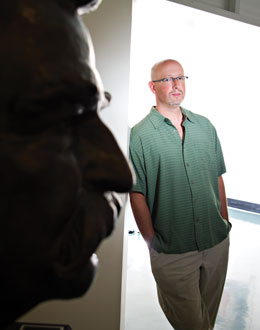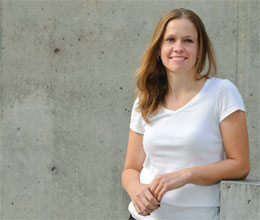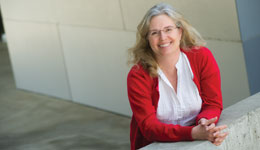Volume 28 · Number 4 · Summer 2011
Bringing history to life

Ari Kelman is an associate professorof history
(Karin Higgins/UC Davis)
At 4:30 p.m. on a sunny Wednesday afternoon, with their students gone and their classrooms closed, about 30 teachers are just getting started on their own lesson in U.S. history. They are gathered in the Tennessee Room of the Sacramento City Unified School District's administration building to hear UC Davis historian Ari Kelman speak, as part of the UC Davis History Project, about the Civil War.
Arranged around a series of institutional-grade tables, their names inked on blue- and green-paper name tags, the schoolteachers have prepped for the lecture by having first read, and discussed, historic documents: a copy of "A Letter from Bleeding Kansas," penned in the 1850s when skirmishes erupted on the Kansas-Missouri border between pro-slavery and free-labor forces; a poster printed by Boston abolitionists; a transcript of a speech given by an anti-slavery minister; and texts of arrest warrants issued under the rubric of the Fugitive Slave Act.
Kelman begins talking about a series of crucial events and developments, psychological shifts, that prefaced the formal outbreak of hostilities between a secessionist South and the rest of the Union: the aftermath of the U.S.-Mexican war of 1848, the California Gold Rush, the violence in Kansas, the rise of the abolitionist movement, the Fugitive Slave Act, and so on. But as he reels off the highlights, Kelman urges his audience of teachers to go beyond reciting the mere litany of dates that all too often passes for history. The Civil War wasn't a self-enclosed event that began in 1861 and ended in 1865, he explains. In reality, the conflict developed over decades, beginning not with the first shots fired 150 years ago at Fort Sumter, but in the newly acquired territories of the West, as a series of battles about whether slavery could, or should, be extended toward the Pacific.
"The North had been bound up with the institution of slavery for decades," Kelman argues. Financially, legally, and politically, the North had a stake in slavery and its opinion-leaders were willing to tolerate its continued existence in one quadrant of the country. But, says Kelman, at a certain point, a critical mass of northerners began to feel they had more to lose financially from slavery's continuation — and its undermining of free labor — than they stood to gain; and, moreover, an increasing number of northerners came to regard the institution as a moral stain on America's character. Whereas moral "abolitionists" were at one time considered by their fellow northerners to be "somewhat beyond the pale politically," by the 1850s they were coming to the fore politically. And, at the same time, southerners were starting to define slavery as a "positive good" rather than a "necessary evil." As the middle-ground of the slavery debate fell away in the 1850s, so the stage was set for conflict.
Getting teachers and their students to go beyond a litany of facts, and to understand context, to appreciate the dynamic nature of society, is the intention of the California History–Social Science Project, an ambitious university-schools collaboration that grew out of a pilot project run out of UC Berkeley in the 1970s, and a UCLA institute created in 1989. The History Project at UC Davis is now in its 20th year of existence.
At the high-water mark, there were 18 local chapters scattered around California, funded by the UC Office of the President, the state's Department of Education, Teaching American History grants (a pet project of the late West Virginia Democratic Sen. Robert Byrd) and a handful of other state and federal grants. Now, after years of budget cuts, the $800,000 per annum project is down to seven locales; UC Davis is one of them, responsible for the six-county region around California's capital (El Dorado, Placer, Sacramento, Solano, Yolo and Yuba counties).
For Kelman, an associate professor who specializes in the Civil War and Reconstruction, it's a vital part of his professional work.

Jessica (Shera) Williams '98 is a high school teacher in Winters. (Karin Higgins/UC Davis)
Kelman is a fluid speaker, at ease without either a slide presentation or notes. As he lectures, he paces back and forth, three steps in one direction, stop, turn, three steps in the other direction. He waves his hands to reiterate his points. He wears his dark brown-checkered shirt with the sleeves rolled up, top two buttons undone. His bald head shines under the fluorescent lighting.
The audience at these History Project presentations is made up of upper elementary, middle and high school teachers who don't have academic backgrounds in history. These are men and women whose job it is to teach teenagers how to understand the past and, by extension, give them the tools to better understand the present — but who themselves might be only a textbook chapter ahead of their students in their own understanding of the topic. "I've taught high school about 10 years," says 35-year-old Winters High School teacher Jessica (Shera) Williams, who graduated in 1998 from UC Davis with a bachelor's degree in political science. "I got involved with the History Project my first year of teaching. I went to the summer institute and to book retreats. It's given me a better opportunity to include content knowledge and stay current with history, figure out what the latest research is."
For Brian Riley, an 18-year teaching veteran, currently employed at Vacaville High School, the History Project seminars "define things better. History's far more than dead people and dates. It's an interpretative discipline. It's about an argument. It [participation in the History Project] has changed the way I teach history and interact with my kids."
When Kelman speaks to these audiences, he is building up their basic knowledge, and also framing his topic in a way that lends itself to questions, synthesizing complex issues and events, spinning a fantastic web of connections for the teachers to take back to their school rooms around the region. It's antithetical to the way history is all too often taught; and it's designed to get school kids, and their teachers, to engage with history in a far more demanding way than that mandated by the state standards. Quite simply, it's about bringing history to life.
After Kelman leaves for his home in Davis, the teachers convene around a buffet table to eat takeout food and discuss their hour-long history lesson. In their packets are green worksheets, with questions about how to interpret the Bleeding Kansas letter. Assuming that Kelman's words have done their trick, these teachers will now be better able to answer the questions than they were only an hour ago.
And the broader hope? At the backend of it all, kids whose teachers have received this adrenaline shot of historiography will graduate from high school with a better sense of history — of what it is and why it is relevant — and take that extra knowledge with them into their undergraduate studies and the workplace.
UC Davis' History Project has four full-time employees, all ex-teachers, and a couple of part-timers. And the head of the entire statewide History Project, Nancy McTygue, is also based at the UC Davis campus — in a small office in the Social Sciences and Humanities Building.
A former high school history and government teacher, McTygue earned her bachelor's degree ('88), teaching credential ('89) and master's degree ('96) from UC Davis. She has long fought against what she considers the "marginalization of the discipline" of history. "We try to support teachers who are teaching history, and advocate for them with their administations."
Despite the History Project's limited staff numbers, its goals are bold. Members of the history faculty speak to teachers either in school district locales or, over the summer, on the campus itself. Each year, more than 400 local teachers, all of them volunteers, partake in its classes and seminars. While some are return participants, motivated by the chance to sit in for free on classes with some of the country's top historians, many are new to the program. All told, over the past couple decades, project coordinators estimate that upwards of 5,000 teachers in the region have attended classes held by UC Davis historians.

Nancy McTygue'88, cred. '89, M.A. '96, is executive director of the statewideHistory Project. (Karin Higgins/UC Davis)
For McTygue, the need for the program is clear. Knowledge of history, she explains, helps people "to understand the concept of significance," meaning they can distinguish between events of import — things that have the potential to change individuals' and communities' life trajectories — and those that don't leave a durable mark. But, as education cuts have gotten closer to the bone, and as more and more schools have simply taught to the test, history teaching has taken a series of hits. In many cases, low-income elementary and middle schools have simply stopped teaching history — because historical knowledge isn't tested until students are in eighth grade — wrongly assuming that high schools can and will pick up the slack.
But since California education standards for social sciences in high schools require instruction only in 20th century history, that leaves a rather large pool of ignorance for students to fall into. Absent history teaching in schools, says McTygue, universities will be accepting freshmen over the coming decades "who have no knowledge of our history. And there's no common conversation or place to start." Quite simply, with an at-best fuzzy knowledge of history, students are emerging into adulthood unaware of the common themes that shape a community and, over time, define a country.
In response to the cutbacks, history professors, inside and outside of the History Project, have held a series of "History Summits" to highlight the need for solid teaching in the schools.
At one time or another, most every UC Davis history professor who specializes in U.S. history — and a few who don't — has talked with the teachers at the History Project's after-school and summer programs. Professor Lorena Oropeza has interacted with teachers about such issues as Woodrow Wilson's foreign policy, New Mexican land grant campaigns and the rise of the Brown Power movement in the 1960s. "It's really fun, so much fun," says Oropeza. "I'm enthusiastic about thinking about history, and I'm in a crowd enthusiastic about history. I just kind of swoop in, then I swoop out. Sometimes I stay for a bagel. It's an absolute joy."
Pulitzer-prize winner Alan Taylor has lectured on the Colonial period, the Revolutionary War and the early years of the Republic.
Wearing a silk tie imprinted with a copy of a painting of the Constitutional Convention, and sitting in his small UC Davis office, lined floor to ceiling with history books, Taylor clearly loves his craft. In his History Project lectures, he seeks to pass this enthusiasm down the line. The History Project, he explains, works on teachers' communication skills, getting them to "connect facts with a kind of storytelling that is at the heart of history."
Teachers are taught how to use first-hand accounts and other primary sources, how to encourage students' analytic skills, how to understand grand events not simply as a series of names and dates, but as complex, dynamic stories. Too often, says Pamela Tindall, the History Project's UC Davis director, state standards, crafted by nonhistorians, reduce history to a series of checklists. Historians, by contrast, "connect everything;" they fill in the tissue between the skeletal structures of the standards.
Winters teacher Williams says her involvement with the History Project has given her the confidence to ask her students to use primary sources, to use evidence to formulate arguments rather than simply parrot facts back to her. "I'm teaching U.S. history. We're talking about the 1950s. I wanted my students to take a look at suburbia, what it was — the good that came out of it, but also the conformity. I gave my students a set of documents and investigative questions."
And that approach gives the students more than a lesson in history, she says. "I'm teaching the whole process of critical thinking."
While there have been only a few studies so far measuring the effectiveness of the History Project, their findings are encouraging. In one study involving 52 Sacramento-area educators, UC Davis staff found that teachers who have been through the program show statistically significant improvements in how they use historical evidence in their teaching, how they analyze texts, and how their students structure arguments and write about historical events. Students whose teachers had engaged with the project showed improved abilities to identify primary and secondary sources, were more likely to understand that there can be more than one side to an argument, and were better able to place important events in historical timelines.
"For me, I undersand how history is done more," says Williams. "I understand the process of history — and I can impart that to my students. Instead of teaching a list of facts, I can teach them how to interpret facts themselves. It makes the class more dynamic."
The UC Davis historians want to show teachers how to look for "root rather than proximate causes" of events, Kelman says. "I'm bringing historiography [the writing of history] to them — and saying to them, 'Here is the state of the art. This is how historians are thinking about these issues right now.'"
Or, as statewide project director McTygue puts it, the goal is to "remind people about something they've forgotten — understanding their country's history. [Knowing] the world's history is important if you're going to have the skills to participate in a democracy."
Learn more:
The History Project at UC Davis
